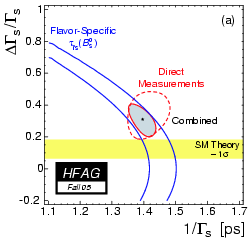
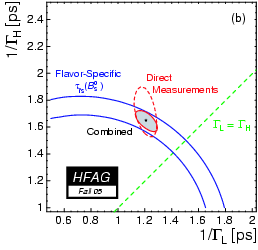
(1/&Gammas, &Delta&Gammas/&Gammas)eps / (1/&GammaL, 1/&GammaH)eps /
| WARNING |
The averages presented on this page,
performed after the Winter 2006 conferences, do not represent
a complete set of averages. Only the Bs oscillation combination has been
updated, based on the new dms results released by D0 in mid-March 2006
and by CDF in mid-April 2006.
No other new measurement has been included in the averages presented on
this page (as compared to the "end of 2005" averages published in
hep-ex/0603003).
However, two sets of averages for chibar and for the b-hadron fractions at high-energy are now presented: one set using only measurements performed in Z decays, i.e. LEP measurements (new), and a second set including all measurements at LEP and Tevatron (as previously). |
All results available publicly (published and preliminary)
have been included in the averages computed by the
lifetime and oscillations sub-group
of the Heavy Flavour Average Group (HFAG).
The following material is available publicly:
(home , top , next, previous )
| b hadron species | average lifetime | average lifetime relative to B0 average lifetime |
| B0 | 1.527 +- 0.008 ps | |
| B+ | 1.643 +- 0.010 ps | 1.076 +- 0.008 |
| Bs | 1.461 +- 0.040 ps | 0.957 +- 0.027 |
| Bc | 0.469 +- 0.065 ps | |
| Lambda_b | 1.288 +- 0.065 ps | |
| Xi_b-, Xi_b0 mixture | 1.39 +0.34 -0.28 ps | |
| b-baryon mixture | 1.242 +- 0.046 ps | 0.813 +- 0.030 |
| b-hadron mixture | 1.568 +- 0.009 ps |
| mixture of the two Bs mass eigenstates | average lifetime |
| Bs -> flavour specific | 1.454 +- 0.040 ps |
| Bs -> J/psi phi | 1.404 +- 0.066 ps |
These results are used as input to extract the long and short lifetimes
of the Bs system (see next section).
Combined result on the relative decay width difference in the B0 system:
| s*&Delta&Gammad/&Gammad = 0.009 +- 0.037 | from BABAR and DELPHI |
The quantity s = sign(Re(&lambdaCP)), where &lambdaCP = (q/p)*AbarCP/ACP refers to a CP-even final state (e.g. J/psi K_long), is predicted to be equal to s= +1 to a high degree of confidence from the Standard Model fits to all available contraints on the unitarity triangle.
Combined results on the decay-width difference in the Bs system are extracted from a global fit including all direct measurements of &Delta&Gammas/&Gammas, as well as the lifetime measurements using Bs -> J/psi phi decays and flavour-specific Bs decays (ALEPH, CDF and DELPHI data). The results in the table below are shown both with and without constraining the quantity (1/&Gammas) * (1 + (&Delta&Gammas/&Gammas)2/4) / (1 - (&Delta&Gammas/&Gammas)2/4) to the flavour-specific Bs lifetime average:
| Fit results from ALEPH, CDF and DELPHI data |
without constraint from tau(Bs -> flavour specific) |
with constraint from tau(Bs -> flavour specific) |
| &Delta&Gammas/&Gammas (95% CL range) | [ +0.01 ; +0.59 ] | [ +0.01 ; +0.57 ] |
| &Delta&Gammas/&Gammas | +0.35 +0.12 -0.16 | +0.31 +0.10 -0.11 |
| &Delta&Gammas | +0.25 +0.09 -0.11 ps-1 | +0.22 +- 0.08 ps-1 |
| 1/&Gammas | 1.42 +0.06 -0.07 ps | 1.396 +0.044 -0.046 ps |
| tau(short) = 1/&GammaL | 1.21 +0.08 -0.09 ps | 1.21 +- 0.08 ps |
| tau(long) = 1/&GammaH | 1.72 +- 0.19 ps | 1.65 +0.07 -0.08 ps |


(1/&Gammas, &Delta&Gammas/&Gammas)eps /
(1/&GammaL, 1/&GammaH)eps /
| dmd = 0.508 +- 0.004 ps-1 | from time-dependent measurements at ALEPH, DELPHI, L3, OPAL, CDF, D0, BABAR, BELLE |
| &chid = 0.182 +- 0.015 | from time-integrated measurements at ARGUS and CLEO |
Assuming no CP violation in the mixing and no width difference in the B0 system, and assuming a B0 lifetime of 1.527 +- 0.008 ps (the experimental average listed above), all above measurements can be combined to yield the following world averages:
| dmd =
0.507
+-
0.004
ps-1
xd = 0.775 +- 0.008 &chid = 0.188 +- 0.002 |
from all ALEPH, DELPHI, L3, OPAL, CDF, D0, BABAR, BELLE, ARGUS and CLEO measurements |
In the plot below, all individual measurements are listed as quoted by the experiments; they might assume different physics inputs. The averages (which take into account all known correlations) are quoted after adjusting all the individual measurements to the common set of physics inputs. The &chid average from ARGUS and CLEO is converted to a dmd measurement assuming no CP violation, no width difference in the B0 system and a B0 lifetime of 1.527 +- 0.008 ps.
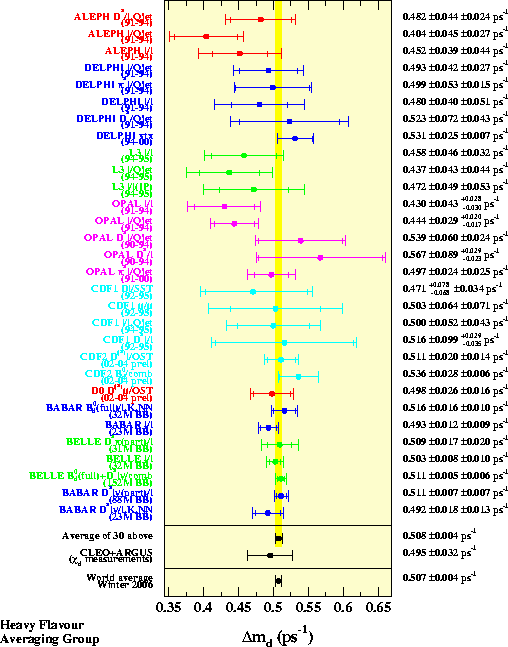
colour eps /
black-and-white eps /
Same without average including time-integrated (&chid) measurements:
colour eps /
black-and-white eps /
Only measurements and average at LEP and CDF1:
colour eps /
black-and-white eps /
Only measurements and average at LEP:
colour eps /
black-and-white eps /
Only measurements and average at asymmetric B factories:
colour eps /
black-and-white eps /
In the plot below,
all individual experiment averages are listed as quoted by the experiments
(or computed by the working group without performing any adjustments);
they might assume different physics inputs. The global averages are quoted
after adjusting all the individual measurements to the common set of physics
inputs. The &chid average from ARGUS and CLEO is converted to a dmd measurement
assuming no CP violation, no width difference in the B0 system and a
B0 lifetime of
1.527
+-
0.008
ps.
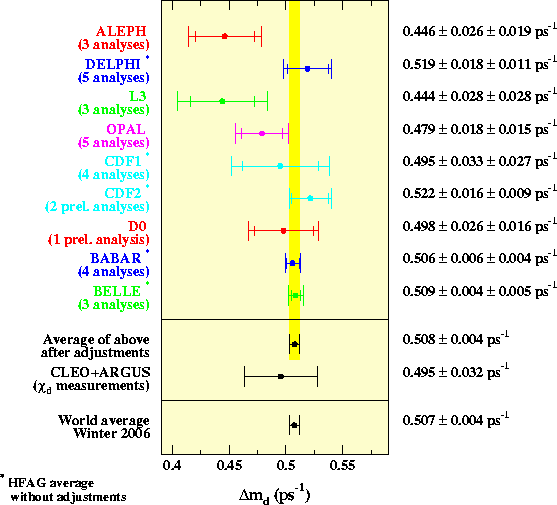
colour eps /
black-and-white eps /
| dms = 17.33 +0.42 -0.21 (stat) +- 0.07 (syst) ps-1 | CDF (Run II) |
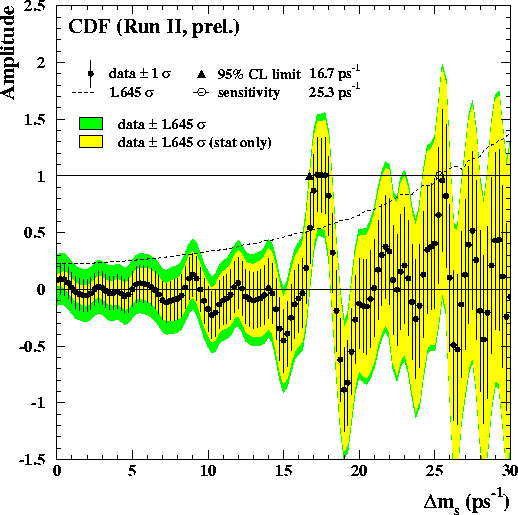
colour gif /
colour eps /
ASCII file with numerical data /
The CDF result can be combined with other results performed at the
Tevatron (old CDF Run I result and new D0 Run II result).
This Tevatron combination exhibits a signal with
a significance of 3.3 sigma at 17.75 ps-1 (defined as the maximal
value of the combined amplitude divided by its total error, scanned in steps
of 0.25 ps-1).
colour gif /
colour eps /
ASCII file with numerical data /
Note: There is some debate in the Tevatron community
about the combination of results from analyses
which have a proper-time dependent efficiency. This
time-dependence is believed to cause some undershoot on either side of
a signal or a fluctuation in the amplitude spectrum. Some people
wonder whether the individual amplitude spectra need
to be corrected for this effect before they are averaged.
If CDF and D0 decide to provide "corrected" amplitude spectra,
these will be used in future HFAG averages.
The plot below shows the world-averaged Bs oscillation amplitude as
a function of dms, once all
all published results from ALEPH, DELPHI, OPAL and SLD are included in
addition to the Tevatron results. All measurements
have been adjusted to the common set of inputs before averaging. Systematic
correlations are taken into account.
The signal has now an increased significance of
3.8 sigma at 17.5 ps-1. All values of dms
up to 25 ps-1 except those between
16.7
ps-1 and
18.3
ps-1 (i.e. all values of dms for which
the combined amplitude plus 1.645 times its total uncertainty is smaller than 1)
are excluded at 95% CL.
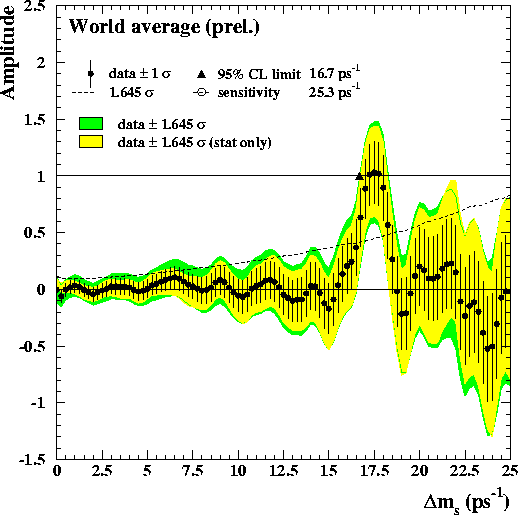
colour gif /
colour eps /
ASCII file with numerical data /
The above world average spectrum can be converted into a negative log-likelihood curve. The minimum is close to 17.5 ps-1, perhaps between 17.25 and 17.50 ps-1 (?).
gif1 /
eps1 /
gif2 /
eps2 /
ASCII file with numerical data /
Note: A combination with a smaller step size would be needed to extract
a measurement of dms corresponding to the world average. The Tevatron
collaborations may still provide their results with a smaller step size,
as this is no longer possible for the ALEPH, DELPHI, OPAL
and SLD collaborations.
In the plot below,
all individual measurements of the Bs oscillation amplitude at a fixed
value of dms = 17.5 ps-1 are listed as quoted by the experiments
(or obtained by a linear interpolation between other dms values at which
the experiment did the measurements);
they might assume different physics inputs. The sensitivity quoted
for each experiment is obtained from the positive amplitude uncertainty,
without performing adjustments.
The average and combined sensitivity are obtained
after adjusting all the individual measurements to the common set of physics
inputs. The sensitivities are defined as the value of dms at which
the positive uncertainty on the measured amplitude is equal to 1/1.645;
they correspond to sensitivities for 95% CL exclusion limits.
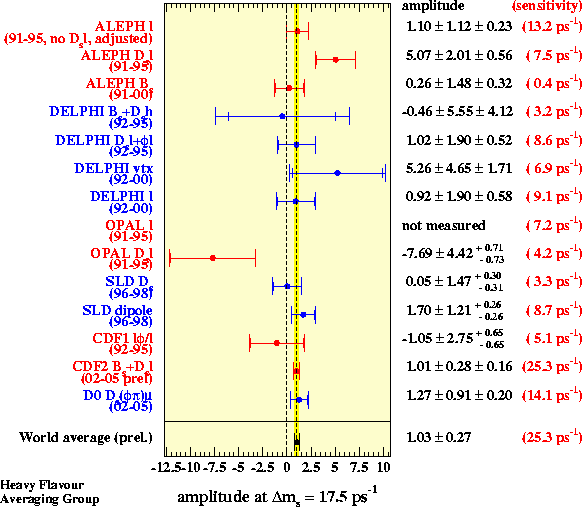
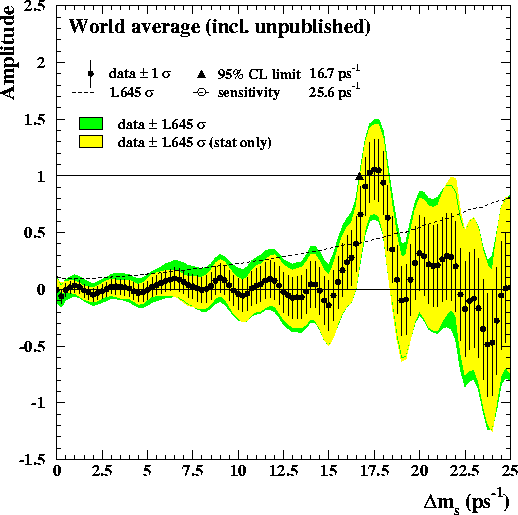
colour gif /
colour eps /
ASCII file with numerical data /
There is CP violation in the mixing if |q/p| is different from 1, i.e. A_SL is different from 0. The averages given below for the B0-B0bar system are all equivalent.
|
|q/p| =
1.0015
+-
0.0039
A_SL = -0.0030 +- 0.0078 Re(epsB)/(1+|epsB|**2) = -0.0007 +- 0.0020 |
from measurements at LEP, CLEO, BABAR and BELLE |
| f+-/f00 = 1.020 +- 0.034 | from ratios of reconstructed B+ and B0 mesons
at BABAR, BELLE and CLEO
(assumptions made, see text above) |
| f00 = 0.487 +- 0.013 | from absolute measurement of
B0 mesons at BABAR
(no assumptions) |
Assuming f+- + f00 = 1, the above two independent results
(which are consistent with each other)
can be combined to yield:
| b hadron species | fraction in Upsilon(4S) decay | ratio |
| B+ B- | f+- = 0.507 +- 0.007 | f+-/f00 = 1.030 +- 0.029 |
| B0 anti-B0 | f00 = 0.493 +- 0.007 |
| b hadron species | fraction in Z decays | correlation with f(Bs) | correlation with f(b-baryon) |
| Bs | f(Bs) = 0.103 +- 0.009 | ||
| b baryons | f(b-baryon) = 0.098 +- 0.016 | +0.049 | |
| B0 or B+ | f(Bd) = f(Bu) = 0.399 +- 0.010 | -0.522 | -0.878 |
| chibar(LEP) = 0.1259 +- 0.0042 | LEP average from LEP EW WG |
| b hadron species | fraction at high energy | correlation with f(Bs) | correlation with f(b-baryon) |
| Bs | f(Bs) = 0.104 +- 0.013 | ||
| b baryons | f(b-baryon) = 0.099 +- 0.020 | -0.097 | |
| B0 or B+ | f(Bd) = f(Bu) = 0.398 +- 0.011 | -0.499 | -0.814 |
| chibar = 0.1259 +- 0.0042 | LEP average from LEP EW WG |
| chibar = 0.152 +- 0.013 | CDF measurement |
| chibar = 0.1283 +- 0.0076 | weighted average of above two, with error rescaled by factor 1.9 according to PDG prescription |
Note: